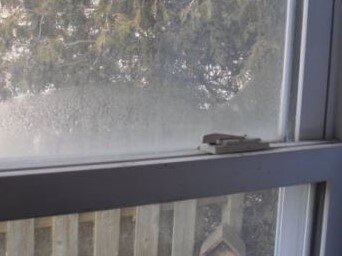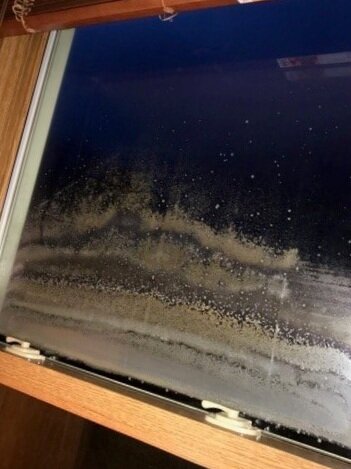Condensation: What Is It and Why Do I Have It?
Even though summer is over, just pretend with me (for one second) that it isn’t. It’s the middle of July, but not the July we’ve had the past couple of years - no, a hot July. One where you walk outside and you feel like you can bite the air, it’s so humid. A day you spend beside the pool, lounging in the shade, while the kids splash in the water until you call them out to eat and apply another layer of sunscreen. A day where the ice in your drink doesn’t seem to last very long and only manages to water down whatever it is in the glass. As a matter of fact, it seems there’s more water on the outside of your glass, than there is inside.
We all know what condensation on our water bottle on a hot July day looks like, and we usually know why it’s there: the cold water inside the bottle cools the surface of the bottle, so the warmer, humid outside air collects (and puddles) on the non-porous surface. That makes total sense. But why do my brand-new, supposedly energy-efficient windows have condensation on them in the morning?! These aren’t supposed to condensate!
Here’s the basic idea behind condensation: when there’s moisture in the air, it collects on cool surfaces; the warmer the air, the more moisture it carries. The moisture in the air is humidity. The higher the humidity, the more likely extra water will collect on the first cool, non-porous object or surface it finds.
For example, this time of year it can reach upwards of 70 degrees during the day and as low as 20 degrees overnight. This dramatic temperature change causes excess moisture in the air. The hotter temperatures during the day evaporates the water outside and allows the air to carry the extra moisture (this is one of those days where the humidity is really high and you feel like you can drink the air). When the temperature drops at night, the air releases the moisture and it collects as dew.
When the outside air is colder than the air inside your home, the moisture in the air will find the coolest place to gather: your windowpane. Humidity will always collect on the coolest surface, normally your glass; so when it’s warm inside your home, but cool outside (which makes the glass cool), the moisture collects on the inside. The opposite is also true: when the air inside your house is colder than the air outside (think of a hot summer day), the air inside your home wants to find the coolest place to dump its moisture: the glass on your window. That just happens to be on the outside.
Confused? Lost in the words? Just doesn’t make sense? Imagine a pot of water on your stove. You want to boil the water, so you turn the burner on. The heat from the stove causes the water (in the liquid form) to begin boiling, which releases steam (gas form). The steam gets trapped onto the cool glass of the lid for the pot and collects as a liquid again. When you take the lid off the pot, you’ve got that condensation buildup you try not to let fall back into the pot (or is that just me? …Just me? Never mind.). Your house is like a giant pot of water. All the water molecules trapped in the porous surfaces of your home end up getting “boiled” away since the furnace dries out the air in your home as the furnace heats it. When the “steam” hits the cool glass lid (or in this case, the cool glass in your window), the cold temperature rapidly changes the hot steam back into liquid water: which is the condensation.
So what the heck can you do about it?! The truth is: if you have excessive moisture (I’m talking the water is literally dripping and pooling on the sill), run a dehumidifier. If the dehumidifier doesn’t stop the condensation after a few days, there may be a further issue, and that’s when you should give us a call to come out and take a look. If it’s not excessive, just wipe it off with a towel or leave it be (it will evaporate on its own as the temperature of the glass evens out).
“Okay, but what if the water is in between the panes of glass?
I can’t wipe it off and a dehumidifier doesn’t make it go away.”
Good news! You aren’t crazy! That’s actually a different issue called “seal failure.” When the glass loses part of the seal holding in the gases between the panes, it creates that fog you see which can’t be wiped away. Give us a call (or your window manufacturer/installer) and we’ll get that all squared away for you.
One final thought about condensation: this is a very prevalent issue around this time of year. The air outside cools down and we start running our furnaces. If your furnace happens to be a “forced-heat” furnace, you’ve got it particularly bad. All the moisture in our homes collects during the summer (because of the high humidity) and is stored in porous surfaces around the house (carpets, drapes, rugs, wood, etc.). When we heat our homes, this moisture evaporates from those porous surfaces and collects in the air as humidity. Since there’s always moisture in the air, it’s always searching for the coolest, non-porous place to collect. Excess humidity = condensation.
The key takeaways:
1) Condensation does not mean you have faulty or less-than-good quality windows. In fact, it means your windows are doing their exact job: to keep the temperature regulated in your home and not waste energy.
2) If you have condensation, try running a dehumidifier for a few days.
3) If you have excessive condensation and the dehumidifier doesn’t get rid of it: give us (or your window manufacturer/installation company) a call.
4) Seal failure is different than condensation: seal failure is in between the glass on your windows and cannot be gotten rid of by wiping the glass or the use of a dehumidifier.
5) Even the highest-quality windows experience condensation when you live where we do and experience the seasons like we do.
6) Excess humidity = condensation.






